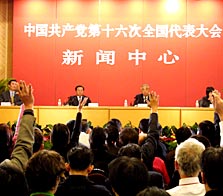 Market demand now plays a dominant role in allocating human resources in China, and a social security framework with Chinese characteristics has taken initial shape, a leading labor official said yesterday in Beijing.
Market demand now plays a dominant role in allocating human resources in China, and a social security framework with Chinese characteristics has taken initial shape, a leading labor official said yesterday in Beijing.
Speaking at a press conference held on the sidelines of the ongoing 16th Party Congress, Zhang Zuoji, minister of labor and social security, said that the country has witnessed expanded employment, great progress in re-employment and fundamental changes in its employment structure over the past 13 years.
According to Zhang, the number of people employed across the country rose to 730 million in 2001 from 650 million in 1990.
The service industry has become a major channel for surplus laborers. Its share of the employment pie increased from 18.5 percent in 1990 to 27.7 percent in 2001, the minister said.
The rapid development of individual and private businesses has also contributed greatly to the country's employment efforts. Statistics indicate that 30 million urban residents, representing 40 percent of the total increase in urban employment, found jobs in the private sector from 1990 to 2001, said the minister.
Substantial progress has been made in re-employment with 17 million out of the total 26 million laid-off workers from State-owned enterprises (SOEs) having found new jobs from the beginning of 1998 to June of 2002, said Zhang.
The past 13 years have been the best period for the establishment of a social security system with Chinese characteristics, he said. Three social security schemes have been in full operation across the country, catering to the needs of laid-off workers from SOEs, the jobless and the urban poor respectively, according to Zhang.
By September 2002, the number of people shielded by unemployment insurance totaled 101 million, an increase of 36 million over 1989's figure, Zhang said.
Headway has also been made in reforming the pension insurance system, and the reform of the comprehensive medical insurance system has been initiated, he said.
Meanwhile, employees' wages have increased and the legal rights and interests of the workers have been well protected, the minister said, adding that the number of public holidays was increased from 59 to 114 days per year since the mid 1990s, an improvement in the quality of people's lives.
In response to questions on the unemployment rate and on providing social security to rural people, Zhang said that the current registration system of urban unemployment does not take into account laid-off workers from SOEs or farmers seeking jobs in cities.
China's unemployment rate is expected to be kept under 4 percent this year, 0.5 percentage points lower than the expected figure, the minister said.
At present, around 60 million farmers are participating in some kind of social security scheme and 1.08 million have started to collect pension benefits, Zhang said.
Party General Secretary Jiang Zemin's report delivered on Friday sent a clear signal to social security workers that they should forge ahead with explorations of setting up a pension system, a medical-care system and a minimum living standard payment system in rural areas where conditions are ripe, Zhang said.
A senior trade union official also said at the press conference that trade unions across China have played an important role in promoting democratic management inside enterprises and helping safeguard the legitimate rights and interests of employees.
Zhang Junjiu, vice-chairman of the All-China Federation of Trade Unions (ACFTU), declared that the country had established nearly 2 million trade unions branches at the grass-roots level by the end of June 2002, with a record 130 million members.
The trade unions have also helped improve the country's social security system and promote re-employment, he said.
According to Zhang, the trade unions helped nearly 3 million laid-off workers find new jobs in the past five years, and launched training courses to help improve the job skills of 3.19 million laid-off workers.
The trade unions have also been keen to protect the legitimate rights and interests of working people, Zhang added.
Taking a question about trade unions in joint ventures and in foreign-funded enterprises in some parts of the country -- the coastal regions of Southeast China in particular -- Zhang said he is not satisfied with the situation there.
"Some foreign-funded, private or newly established enterprises simply do not have trade unions," he said.
The ACFTU will follow international practices and help those enterprises set up trade unions to better protect the rights and interests of the employees and more smoothly tackle labor disputes, the vice-chairman said.
(China Daily November 12, 2002)
| 














